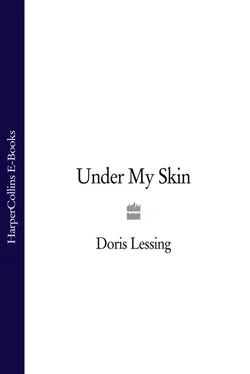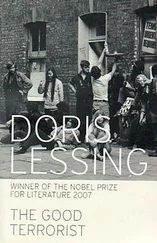It was mid-year of 1927 when I returned finally from Mrs Scott’s, for I was due to go to the Convent, for which I was already being primed by warnings that they – the RCs – would try to ‘get me’ and I must be on my guard. The Convent, which always had more Protestant than Catholic pupils, was used to assuring anxious parents that the souls of their offspring were safe with them. The Convent, like convents in Britain, was supposed to be more genteel than the High School. I am always meeting women now who were sent to convents for the same reason. That the convent in Salisbury had this reputation was because of false comparisons with Home. I had been given a bursary. Into the third year on the farm it was evident things were going badly and not likely soon to get better. My father was building tobacco barns, because maize was no longer where fortunes were being made. And was he, with his wooden leg, his limited mobility, planning to get up several times during the night to check the temperatures in a barn a good mile away?
We could not have afforded unaided my uniform for the convent, piled on chairs and beds everywhere through the house. Pleated tunics in heavy brown serge and alpaca, with light orange cotton blouses, springy brown girdles that surely could never stay knotted, white panama hats with brown and orange ribbons, the brown blazer, piles of heavy brown knickers, and many vests and brown socks. Even to look at this stuff was oppressive, but luckily it was still the beginning of the holidays and time stretched endlessly ahead.
Just about then the family became characters in A. A. Milne, just as if we had never left England. My father was Eeyore, my brother Roo, my mother – what else? – Kanga. I was the fat and bouncy Tigger. I remained Tigger until I left Rhodesia, for nothing would stop friends and comrades using it. Nicknames are potent ways of cutting people down to size. I was Tigger Tayler, Tigger Wisdom, then Tigger Lessing, the last fitting me even less than the others. Also Comrade Tigger. This personality was expected to be brash, jokey, clumsy, and always ready to be a good sport, that is, to laugh at herself, apologize, clown, confess inability. An extrovert. In that it was a protection for the person I really was, ‘Tigger’ was an aspect of the Hostess. There was a lot of energy in ‘Tigger’ – that healthy bouncy beast. But it was not Tigger that went off to the Convent, but a frightened and miserable little girl.
Mother Patrick came riding into the colony with her five Sisters just a year after the Pioneer Column in 1890 and they at once set up their hospital and became, but really, sisters of Mercy, because contemporary accounts speak of them like this. It was Mother Patrick who established the Dominican convent and she was, when I got there, a revered figure, spoken of in awed tones, like the other pioneer sisters. Sister Constantia and Sister Bonaventura were, I think, still alive, as silently influential as the statues everywhere of the Virgin. They had been lively and adventurous young women, and the administrative nuns that came after them were a different kind.
The Convent was a central mass with projecting wings, embedded in granite chips. When adults walk over stone chips, the pebbles are not very comfortable underfoot, but for a small child it is like toiling over the big sharp stones on a beach, each a hazard. The staircase to the small girls’ dormitory was steep, every step at thigh-level. The little ones clambered up on hands and knees; going down meant jumping from step to step for the handrail was high above our heads. The day I found myself actually able to step down, the day I ran across the gravel, were markers on the road to being grown-up. This dormitory (which was over the gym), the refectory, the classrooms, the sickroom, were what the pupils knew of the Convent: most of the building was out of bounds to the children, and seemed a ghost story place of vast shadowy rooms full of nuns in their black and white robes floating like shadows. The nuns slept in dormitories too, but we knew white curtains separated their beds, making tight box-like cubicles. The ‘little ones’ dorm’ was a long high-ceilinged room, and in it were three rows of beds, lined up head to foot, twenty-four beds. There were rows of high windows on either side. This large room, or rather, hall, was in daylight well lit and fresh, but at night a different place. A small table that projected into the room, making it necessary always to walk around it, held an assortment of holy objects, small statues like icing-sugar figures on cakes; and above it was a large picture where a man from whose head shot rays like those from behind a storm cloud pointed authoritatively to his swollen heart dripping blood. On the wall facing this altar was a tall picture of a man on whose head was clamped an enormous wreath of Christ-thorn, like that which grew on the kopje, with black spikes an inch or two inches long, and blood ran down his face from the spikes. Other pictures showed a man full of arrows that stuck out like porcupine quills, each in a bloody wound, and a woman holding a plate on which were two pink blancmanges in red jam sauce, but these turned out to be her cut-off breasts. In another a woman stood smiling while being burned to death by flames that curled around her like long witches’ fingers.
When I recently drove through the countryside near Munich I kept coming upon horrific statues of tortured Christ. They were beside or in a pretty stream, or in a wood, a field, a garden. They reminded me of the pictures provided for the instruction of us children in the convent, all relish in blood and torture. The nuns in this convent were nearly all from South Germany, which was Hitler’s country. Stalin the sadist came from a seminary. I was reminded of these feasts of blood when I was in Peshawar at the time when Shiah Muslims celebrate the murder of Hassan and Hussain, the Prophet Muhammad’s grandchildren, more than 1,500 years ago. Young men ran or staggered in hordes through the streets lacerating themselves with heavy chains or whips, eyes blank or shocked with pain, till they fell, to be gathered up in ambulances that were patrolling the streets for just this purpose. Forgive me for the banality of this reflection, but there is something very wrong with the human race.
The youngest children in the great torture room were five or six, and the oldest were ten and eleven.
When we were in our rows of beds, the light was turned off, but the red light that burned always in front of the Sacred Heart and its bloody gouts lit the room with red. The nun in charge of us little ones came to stand in the doorway, the light behind her. In heavy German accents she said, ‘You little children believe you are safe in your beds, you think that do you? Well you think wrong, you think the holy God cannot see you when you lie under the sheet. But you must think again. God knows what you are thinking, God knows the evil in your hearts. You are wicked children, disobedient to God and to the good Sisters who look after you for the glory of God. If you die tonight you will go to hell, and there you will burn in the flames of hell, yes I tell you so, and you must believe me. And the worms will eat you and there will never be an end, it will never ever end.’ She would go on like this for a good ten minutes or so. Then, having cursed us to hell and back, she shut the door and left us to it.
Storms of sobs, and soft shrieks of terror. The older girls crept to the beds of the little ones, to comfort them. ‘It’s only Catholic,’ they would say, ‘we don’t believe all that.’ For most of us were Protestants. The Catholic little girls were protected by rosaries, holy pictures and bottles of holy water under their pillows.
When my parents warned me that the Catholics would try to ‘get’ me they had not foreseen anything like this, I knew that. I knew they would be appalled. This armoured me, and besides, one may believe and not believe at the same time. I do not know for how many years these horrific sermons went on: the impression the first term made on me was so strong I have forgotten the rest. I remember only lying in bed to watch the blood dripping from the big heart like a lump of fresh steak, making myself see that it moved, believing that I could actually see the blood trickling, while I knew perfectly well it didn’t. The tiny children – I was already, at eight, in the middle range – used to cry out in their sleep. Sometimes one would go wandering around among the beds in her sleep, and an older child gently led her back to her own bed. One sleepwalking little girl persistently tried to get into the bed parallel to hers, because there was a kindly older child in it, who quietly made the swap when the small one was asleep at last, the nuns never knowing. In the morning there were dirty stains of urine in many beds. The nuns scolded and punished: for the Catholic girls the repetition of Hail Marys, for us, admonishment and threats.
Читать дальше











